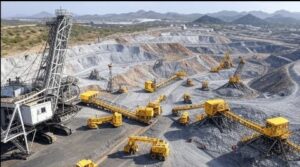TORONTO, Feb. 14, 2018 /CNW/ – Agnico Eagle Mines Limited (NYSE:AEM, TSX:AEM) (“Agnico Eagle” or the “Company”) today reported quarterly net income of $35.1 million, or net income of $0.15 per share for the fourth quarter of 2017. This result includes mark-to-market adjustments and derivative losses of $1.0 million ($0.01 per share), non-recurring losses of $6.8 million ($0.03 per share) and non-cash foreign currency translation losses of $5.5 million ($0.02 per share). Excluding these items would result in adjusted net income1 of $48.4 million ($0.21 per share) for the fourth quarter of 2017. In the fourth quarter of 2016, the Company reported net income of $62.7 million or $0.28 per share.
Not included in the fourth quarter of 2017 adjusted net income above is non-cash stock option expense of $4.1 million ($0.02 per share).
Fourth quarter 2017 cash provided by operating activities was $166.9 million ($209.5 million before changes in non-cash components of working capital). This compares to cash provided by operating activities of $120.6 million in the fourth quarter of 2016 ($120.3 millionbefore changes in non-cash components of working capital). The increase in cash provided by operating activities before changes in non-cash components of working capital during the current period, as compared to the prior period, was mainly due to higher gold sales (up 5%) and a higher realized gold price (up 7%).
“In 2017, we had another strong year of operating performance exceeding our production forecast and beating our cost guidance for the sixth consecutive year. We set a new annual production record while recording the fewest number of lost time accidents, and we also increased our gold reserves”, said Sean Boyd, Agnico Eagle’s Chief Executive Officer. “Furthermore, we continue to make excellent progress on our Nunavut development projects which has allowed us to advance the expected start-up of Meliadine and increase our production guidance for 2018 and 2019. With projected production on track to reach approximately 2.0 million ounces with lower unit costs in 2020, the Company will be focusing on increasing its reserve base and advancing its development pipeline to enhance the production profile and grow free cash flow”, added Mr. Boyd.
____________________ |
1 Adjusted net income is a non-GAAP measure. For a discussion regarding the Company’s use of non-GAAP measures, please see “Note Regarding Certain Measures of Performance”. |
Fourth quarter and full year 2017 highlights include:
- Gold production and costs better than forecast for sixth consecutive year – Payable production2 in 2017 was 1,713,533 ounces of gold on production costs per ounce of gold of $621, with total cash costs per ounce3 of $558, compared to most recent guidance of 1,680,000 ounces of gold at total cash costs per ounce of $585. All-in sustaining costs per ounce4 (“AISC”) for 2017 were $804, compared to most recent guidance of $845 per ounce
- Gold production forecasts increased for 2018 and 2019 as Meliadine start up advanced and Meadowbank extended into 2019; production guidance for 2020 is unchanged at 2.0 million ounces – The production forecast for 2018 is now 1.53 million ounces, compared to previous guidance of 1.5 million ounces. The midpoint of production guidance for 2019 is now 1.7 million ounces, compared to previous guidance of 1.6 million ounces. First production at Meliadine is now expected in the second quarter of 2019, which is approximately one quarter ahead of the initial schedule. The midpoint of production guidance for 2020 is 2.0 million ounces, which is unchanged from previous guidance
- Transitioning to lower unit costs by 2020 as production ramps up – In 2018, total cash costs per ounce are forecast to be between $625 and $675 and AISC are forecast to be between $890 and $940 per ounce. The increased unit costs over the 2017 period are largely due to lower expected gold production in 2018 than in 2017. As the Nunavut business transitions from the Meadowbank deposit to Amaruq and Meliadine, with much higher gold production expected in 2020, total cash costs per ounce are forecast to decline to between $600 and $650, while AISC are forecast to decline to between $825 and $875 per ounce
- Gold Reserves continue to grow as average grade increases – 2017 mineral reserves, net of 2017 production, increased by 3.1% to 20.6 million ounces (257 million tonnes grading 2.49 grams per tonne (“g/t”) gold), while the gold reserve grade increased by approximately 7.7% from the previous year. A large portion of the increase comes from mineral resource conversion at Amaruq. Measured and indicated mineral resources declined by 2.6% and inferred mineral resources declined by 4.3%, however, grades of these mineral resources increased.
- Kittila Shaft Approved for Construction – The Company’s Board of Directors has approved an expansion to add a 1,044 metre deep shaft and increase expected mill throughput by 25 percent to 2.0 million tonnes per annum (“mtpa”) at Kittila. The expansion will be phased in over four years at a capital cost of approximately 160 million euros and is expected to result in a 50,000 to 70,000 ounce annual increase in gold production at reduced operating costs beginning in 2021. The shaft is expected to provide access to the mineral resource areas below 1,150 metres which could further extend the mine life
- A quarterly dividend of $0.11 per share has been declared
___________________ |
2 Payable production of a mineral means the quantity of mineral produced during a period contained in products that are sold by the Company, whether such products are shipped during the period or held as inventory at the end of the period. |
3 Total cash costs per ounce is a non-GAAP measure, and unless otherwise specified, is reported on a by-product basis. For a reconciliation to production costs and for total cash costs on a co-product basis, see “Reconciliation of Non-GAAP Financial Performance Measures” below. See also “Note Regarding Certain Measures of Performance”. |
4 All-in-sustaining costs per ounce is a non-GAAP measure, and unless otherwise specified, is reported on a by-product basis. For a reconciliation to production costs and for all-in sustaining costs on a co-product basis, see “Reconciliation of Non-GAAP Financial Performance Measures” below. See also “Note Regarding Certain Measures of Performance”. |
Fourth Quarter and Full Year 2017 Financial and Production Highlights
In the fourth quarter of 2017, strong operational performance continued at the Company’s mines. Payable production in the fourth quarter of 2017 was 413,212 ounces of gold, compared to 426,433 ounces in the fourth quarter of 2016. A detailed description of the production performance of each mine is set out below.
Production costs per ounce for the fourth quarter of 2017 were $697, compared to $598 in the fourth quarter of 2016. Total cash costs per ounce for the fourth quarter of 2017 were $592, compared to $552 in the fourth quarter of 2016. The increase in production costs per ounce and cash costs per ounce for the fourth quarter, when compared to the prior-year period, is as a result of higher minesite costs and lower production in the quarter. AISC for the fourth quarter of 2017 were $905, compared to $832 in the fourth quarter of 2016 due to higher total cash costs and increased sustaining capital spending. A detailed description of the cost performance of each mine is set out below.
For the full year 2017, the Company recorded net income of $243.9 million, or $1.06 per share. In 2016, the Company recorded net income of $158.8 million, or $0.71 per share. The increase was primarily due to higher revenue as a result of higher realized metal prices and higher metal sales volumes.
For the full year 2017, cash provided by operating activities was $767.6 million ($839.4 million before changes in non-cash components of working capital), as compared with the full year 2016, when cash provided by operating activities was $778.6 million ($714.2 million before changes in non-cash components of working capital). The increase in cash provided by operating activities before changes in working capital for the full year 2017 were mainly due to higher revenue as a result of higher realized metal prices and higher metal sales volumes.
For the sixth consecutive year, Agnico Eagle has reported annual gold production in excess of annual guidance. The Company’s payable production for the full year 2017 was 1,713,533 ounces of gold, compared to most recent guidance of 1,680,000 ounces. In 2016, full year production was 1,662,888 ounces. A detailed description of the production performance of each mine is set out below.
Production costs per ounce for the full year 2017 were $621, which was the same as 2016. Total cash costs per ounce for the full year 2017 were $558, below most recent guidance of between $570 and $600. In 2016, total cash costs per ounce were $573. The decrease in cash costs per ounce for full year 2017, when compared to the prior-year period, is primarily due to higher production in 2017.
AISC for 2017 was $804 per ounce, below most recent guidance of between $820 and $870. This compares with AISC of $824 per ounce in 2016. The lower AISC in 2017 period is primarily due to lower total cash costs per ounce and higher production. A detailed description of the cost performance of each mine is set out below.
Capital Spending and Liquidity – Existing Cash and Undrawn Credit Facility Provide Financial Flexibility
The Company continues to maintain its investment grade balance sheet and has adequate financial flexibility to finance capital requirements at its various mines and development projects from operating cash flow, cash and cash equivalents, short term investments and undrawn credit lines.
Cash and cash equivalents and short term investments increased to $643.9 million at December 31, 2017, from the December 31, 2016balance of $548.4 million.
The outstanding balance on the Company’s credit facility remained nil at December 31, 2017. This results in available credit lines of approximately $1.2 billion, not including the uncommitted $300 million accordion feature.
In the first quarter of 2018, the Company marketed notes to institutional investors on a private placement basis. The Company expects to issue $350 million of notes with a weighted average maturity of 13.9 years and a weighted average interest rate of 4.57% in April. The other terms of the notes are expected to be substantially the same as the terms of the existing outstanding notes of the Company.
Total capital expenditures for the full year 2017 were $875 million, compared to most recent guidance of $895 million. The lower capital expenditures largely related to a reduction in development capital spending at LaRonde Zone 5 and Goldex, offset by higher development capital spending at Canadian Malartic. A portion of the capital not spent in 2017 has been rolled forward into the 2018 capital forecast.
Capital Expenditures | ||||||
(In thousands of US dollars) | ||||||
Three Months Ended | Twelve Months Ended | |||||
December 31, 2017 | December 31, 2017 | |||||
Sustaining Capital | ||||||
LaRonde mine | $ | 16,883 | $ | 67,128 | ||
Canadian Malartic mine | 27,281 | 67,878 | ||||
Meadowbank mine | 6,008 | 22,720 | ||||
Kittila mine | 20,679 | 57,079 | ||||
Goldex mine | 11,709 | 30,061 | ||||
Lapa mine | – | – | ||||
Pinos Altos mine | 12,501 | 39,986 | ||||
Creston Mascota deposit at Pinos Altos | 2,446 | 6,753 | ||||
La India mine | 1,750 | 8,159 | ||||
Meliadine project | – | – | ||||
Development Capital | ||||||
LaRonde mine | $ | 10,302 | $ | 22,621 | ||
Canadian Malartic mine | 10,714 | 18,671 | ||||
Meadowbank mine | 12,173 | 88,796 | ||||
Kittila mine | 11,096 | 30,710 | ||||
Goldex mine | 3,060 | 26,989 | ||||
Lapa mine | – | – | ||||
Pinos Altos mine | 851 | 9,351 | ||||
Creston Mascota deposit at Pinos Altos | 909 | 1,355 | ||||
La India mine | 29 | 2,624 | ||||
Meliadine project | 87,175 | 372,071 | ||||
Other | 1,041 | 1,924 | ||||
Total Capital Expenditures | $ | 236,607 | $ | 874,876 | ||
Quarterly Dividend Declared
Agnico Eagle’s Board of Directors has declared a quarterly cash dividend of $0.11 per common share, payable on March 15, 2018 to shareholders of record as of March 1, 2018. Agnico Eagle has now declared a cash dividend every year since 1983.
Expected Dividend Record and Payment Dates for 2018
Record Date | Payment Date |
March 1* | March 15* |
June 1 | June 15 |
August 31 | September 14 |
November 30 | December 14 |
*Declared |
Dividend Reinvestment Plan
Shareholders should use the following link for information on the Company’s dividend reinvestment plan: Dividend Reinvestment Plan
Conference Call Tomorrow
The Company’s senior management will host a conference call on Thursday, February 15, 2018 at 11:00 AM (E.S.T.) to discuss the Company’s fourth quarter and full-year financial and operating results.
Via Webcast:
A live audio webcast of the conference call will be available on the Company’s website www.agnicoeagle.com.
Via Telephone:
For those preferring to listen by telephone, please dial 647-427-7450 or toll-free 1-888-231-8191. To ensure your participation, please call approximately five minutes prior to the scheduled start of the call.
Replay Archive:
Please dial 1-416-849-0833 or toll-free 1-855-859-2056, access code 5699104. The conference call replay will expire on Thursday, March 15, 2018.
The webcast along with presentation slides will be archived for 180 days on the Company’s website www.agnicoeagle.com.
New Three Year Guidance – Production Forecasts Increased for 2018 and 2019; while 2020 Remains on Track for Production of Approximately 2.0 million ounces
The Company is announcing its detailed production and cost guidance for 2018, and mine by mine production forecasts for 2018 through 2020. Production in 2018 is now forecast to be 1.53 million ounces (previously 1.5 million ounces). Given the expected start up of several new operations, the Company is now providing a range of production guidance for 2019 and 2020. Production in 2019 is now forecast to be between 1.63 and 1.77 million ounces (mid point of 1.7 million ounces), which compares to previous guidance of 1.6 million ounces. Production in 2020 is now forecast to be between 1.95 and 2.05 million ounces (mid point of 2.0 million ounces), which compares to previous guidance of approximately 2.0 million ounces.
The increased production guidance for 2019 is partly due to advancing the expected start-up of production at Meliadine to the second quarter of 2019 (previously the third quarter of 2019), and extension of production at Meadowbank (largely through the processing of stockpiles).
Total cash costs per ounce in 2018 are expected to be between $625 and $675 using a C$/US$ foreign exchange rate assumption of 1.25. Total cash costs per ounce in 2018 are expected to be higher than in the 2017 period primarily due to lower production volumes, stronger operating currencies (Canadian dollar and euro), and slightly higher minesite costs per tonne5 at several operations (Meadowbank, Pinos Altos and Creston Mascota). In 2020, using a C$/US$ foreign exchange rate assumption of 1.25, total cash costs per ounce are forecast to decline to between $600 and $650, largely due to higher production volumes.
AISC for 2018 are expected to be between $890 and $940 per ounce. The AISC per ounce in 2018 are expected to be higher than in the 2017 period due to lower production and higher total cash costs. In 2020, using a C$/US$ foreign exchange rate assumption of 1.25, AISC are forecast to decline to between $825 and $875 per ounce, largely due to higher production and lower total cash costs per ounce.
By 2019, the Company expects to have four cornerstone production assets (the LaRonde Complex, Canadian Malartic, Meliadine and the Meadowbank Complex, which includes the Amaruq satellite deposit) each with annual production rates of approximately 250,000 to 400,000 ounces of gold. Beyond 2019, the Company anticipates the Meadowbank Complex production levels to increase as gold grades mined are expected to rise at the Amaruq satellite deposit. In addition, at Kittila, with the proposed expansion, annual production in 2021 and beyond is expected to increase by approximately 25-30% over current levels, to more than 250,000 ounces as new sources of ore are developed underground.
Following a period of increased development capital spending, largely due to the construction of the Meliadine and Amaruq projects in Nunavut, the Company is forecasting a return to free cash generation in the second half of 2019. At current foreign exchange rate assumptions (1.25 C$/US$, 1.20 EUR/US$, 18.00 US$/MXP) total capital expenditures are forecast to be approximately $1.08 billion in 2018 and between $650 and $700 million in 2019 and 2020. Annual sustaining capital expenditures (included in the above) for 2019 and beyond are expected to remain stable at approximately $300 to $325 million.
“We are excited to transition into a larger production base in Nunavut next year. We have also built a platform to drive further production growth beyond 2020. We expect that this increase in production will result in growth in free cash flow per share, which could potentially translate into higher dividends”, said David Smith, Agnico Eagle’s Senior Vice President, Finance and Chief Financial Officer.
_______________ |
5 Minesite costs per tonne is a non-GAAP measure. For a reconciliation of this measure to production costs as reported in the financial statements, see “Reconciliation of Non-GAAP Financial Performance Measures” below. See also “Note Regarding Certain Measures of Performance. |
















